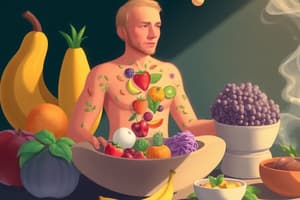Podcast
Questions and Answers
What are the two types of protein structures mentioned in the text?
What are the two types of protein structures mentioned in the text?
- Linear and helical
- Globular and fibrous (correct)
- Alpha and beta
- Primary and secondary
How many different common amino acids are mentioned in the text?
How many different common amino acids are mentioned in the text?
- 25
- 10
- 20 (correct)
- 15
Which type of molecule is responsible for the greasy feel of lipids?
Which type of molecule is responsible for the greasy feel of lipids?
- Carbohydrates
- Glycerol
- Fatty acids (correct)
- Proteins
What is the main function of carbohydrates, proteins, and lipids in the body according to the text?
What is the main function of carbohydrates, proteins, and lipids in the body according to the text?
Which group of vitamins are water-soluble according to the text?
Which group of vitamins are water-soluble according to the text?
What can a shortage of essential vitamins or minerals in the diet lead to according to the text?
What can a shortage of essential vitamins or minerals in the diet lead to according to the text?
What type of nutrients are required in relatively large quantities in the human diet?
What type of nutrients are required in relatively large quantities in the human diet?
Which group of carbohydrates is formed by joining many monosaccharide molecules into chains?
Which group of carbohydrates is formed by joining many monosaccharide molecules into chains?
What is the chemical formula for monosaccharides?
What is the chemical formula for monosaccharides?
Which of the following is a non-reducing sugar among carbohydrates?
Which of the following is a non-reducing sugar among carbohydrates?
What is the ratio of hydrogen atoms to oxygen atoms in carbohydrates?
What is the ratio of hydrogen atoms to oxygen atoms in carbohydrates?
Which type of nutrient is known as micronutrients and required in relatively small quantities?
Which type of nutrient is known as micronutrients and required in relatively small quantities?
Flashcards are hidden until you start studying
Study Notes
Polysaccharides
- Include starch, cellulose, and glycogen (animal starch)
Proteins
- Molecules composed of carbon, hydrogen, oxygen, nitrogen, and sometimes sulfur and phosphorus atoms
- Formed by joining hundreds or thousands of amino acid molecules together in long chains
- Proteins have 20 different common amino acids
- Can be denatured by heat or certain chemicals
- Some are globular in structure and are soluble in water (e.g. hemoglobin and albumin)
- Others are fibrous and are insoluble (e.g. collagen and keratin)
Lipids
- Fats and oils composed of carbon, hydrogen, and oxygen atoms
- Have fewer oxygen atoms than carbohydrate molecules
- Each lipid molecule is made up of four smaller molecules: three fatty acid molecules and one glycerol molecule
- Feel greasy, are insoluble in water, and leave a grease spot on paper
Tests for Carbohydrates, Proteins, and Lipids
- Carried out in a laboratory to identify carbohydrates, proteins, and lipids
- Tests are usually performed on a 2 cm3 solution of the test substance in a test tube
Sources and Functions of Carbohydrates, Proteins, and Lipids
- Supply the body with energy and the materials for growth and repair
- Organic compounds essential for healthy growth and development
Vitamins and Minerals
- Vitamins are organic compounds and minerals are inorganic substances
- Required in small amounts by the human body, but essential for healthy growth and development
- Vitamins: A, D, E, and K (fat-soluble), and Group B vitamins and vitamin C (water-soluble)
- Minerals: calcium, iron, phosphorus, iodine, sodium, potassium, and fluorine
Vitamin and Mineral Deficiency Diseases
- A shortage or lack of essential vitamins or minerals in the diet can lead to health problems and certain deficiency diseases
Nutrition and the Human Diet
- Nutrition is the process by which living organisms obtain or make food
- The human diet must contain carbohydrates, proteins, lipids, vitamins, minerals, water, and dietary fiber
- Carbohydrates, proteins, and lipids are macronutrients, required in relatively large quantities
- Vitamins and minerals are micronutrients, required in relatively small quantities
Studying That Suits You
Use AI to generate personalized quizzes and flashcards to suit your learning preferences.




